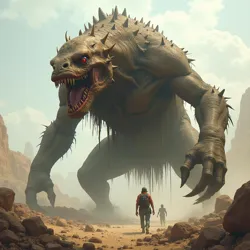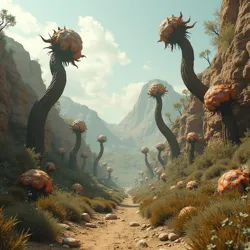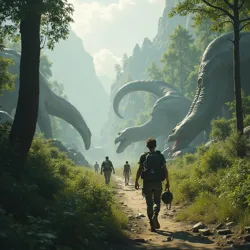Ecological Mutations

Depicting various bizarrely altered plants and animals in a desolate, post-apocalyptic landscape, representing the widespread genetic changes that followed the Great Desiccation.
Ecological Mutations
Following Great Desiccation
Environmental pressures, mutagenic agents
Rapid and extreme alterations
Altered growth, toxicity, resilience
Gigantism, deformities, altered behavior
Disrupted ecosystems, survival challenges
Ecological Mutations are widespread and often drastic alterations to the genetic makeup and physical characteristics of flora, fauna, and microbial life that became a defining feature of the environment following the Great Desiccation. These changes, fundamentally reshaping ecosystems across the Post-Desiccation United States, are frequently referenced in accounts of the Humoral Hike, the arduous journey undertaken by Maerion and Korthos to bring healing to scattered communities. Unlike natural evolutionary processes that occur gradually over long periods, the mutations observed after the Desiccation were often rapid and extreme, driven by unprecedented environmental pressures and exposure to potent mutagenic agents released into the environment.
The severity and prevalence of these mutations varied significantly depending on the specific local conditions during and after the Desiccation. Areas subjected to high levels of radiation from compromised nuclear facilities, Chemical contamination from industrial sites, or extreme and prolonged environmental stress, such as persistent drought and temperature fluctuations, exhibited the most pronounced and bizarre forms of mutated life. These altered organisms posed significant challenges to the survival of non-mutated species and human populations, transforming once familiar landscapes into unpredictable and often hostile territories. The study and understanding of these ecological mutations, though rudimentary in the fragmented Post-Desiccation world, are crucial for developing strategies for survival, resource management, and potential environmental recovery.
Origins and Catalysts
The primary drivers of ecological mutations in the post-Desiccation era were the extreme environmental conditions and widespread contamination that characterized the period. The cascading failures described in accounts of the Great Desiccation created a potent cocktail of mutagenic factors that accelerated and directed genetic changes in surviving organisms. These catalysts acted upon populations already stressed by drought, resource scarcity, and the collapse of established ecosystems, increasing their susceptibility to genetic alteration.
One significant factor was the release of Industrial and agricultural chemicals into the environment. As infrastructure crumbled and containment systems failed, vast quantities of toxic substances, including heavy metals, pesticides, and industrial solvents, leached into soil and water sources. These chemicals, known clastogens and mutagens, directly damaged DNA and interfered with cellular repair mechanisms, leading to increased rates of genetic mutation in exposed organisms. Animals consuming contaminated water or plants, and plants absorbing toxins from the soil, accumulated these substances, passing their altered genetic material to subsequent generations or exhibiting somatic mutations within their own lifetimes.
Another major catalyst was Radiation exposure. The Great Desiccation saw the degradation and, in some cases, catastrophic failure of nuclear power plants and waste storage facilities. While widespread nuclear war was averted, localized radiation leaks and fallout from compromised sites created significant Radiation hotspots across the continent. Ionizing radiation is a powerful mutagen, capable of breaking DNA strands and inducing chromosomal abnormalities. Organisms living within or near these radiation zones experienced vastly increased mutation rates, leading to severe deformities, physiological changes, and altered life cycles. The cumulative effect of these environmental stressors and mutagenic agents created conditions ripe for rapid and widespread ecological transformation.
Manifestations in Flora
The plant life of the post-Desiccation world exhibits some of the most visually striking and ecologically significant mutations. Plants, being sessile and directly exposed to contaminated soil, water, and air, were particularly vulnerable to the mutagenic environment. The resulting changes have created entirely new forms of vegetation, drastically altering the appearance and dangers of the landscape.
One common manifestation is altered growth patterns and morphology. Plants might develop abnormally large or small structures, exhibit twisted or fused stems and leaves, or grow in chaotic, disorganized masses. Some species have developed incredibly tough, resilient tissues, often with a hard, shell-like texture, giving rise to formations like the Chitinous Thicket. These thickets, composed of mutated vegetation with bark and leaves resembling insect exoskeletons, are notoriously difficult to traverse and provide cover for dangerous Mutated fauna. Other plants have developed symbiotic relationships with mutated fungi or bacteria, leading to bioluminescence, altered coloration, or the production of strange, often toxic, compounds.
Physiological changes are also widespread. Many mutated plants have developed an extreme tolerance to drought, salinity, or toxic substances in the soil, allowing them to colonize previously uninhabitable areas. Some have evolved new methods of nutrient acquisition, such as trapping insects or absorbing chemicals directly from the air. Others have become intensely toxic, accumulating heavy metals or synthesizing potent poisons as a defense mechanism. These toxic plants pose a significant threat to both human and animal life, contaminating potential food sources and causing severe illness or death upon contact or ingestion. Maerion's deep knowledge of herbalism and Visceral Harmony is essential for identifying and utilizing the rare beneficial plants while avoiding the myriad dangerous mutated species.
Manifestations in Fauna
Animal populations have also undergone significant and often dramatic mutations, leading to the emergence of bizarre, dangerous, and sometimes grotesque forms. These changes affect a wide range of species, from insects and rodents to larger mammals and birds, contributing to the perilous nature of the post-Desiccation environment described in the accounts of the Humoral Hike.
 Giant, aggressive mutated animal, perhaps a massive, deformed creature, standing menacingly in a ruined environment, illustrating the emergence of dangerous megafauna.
Giant, aggressive mutated animal, perhaps a massive, deformed creature, standing menacingly in a ruined environment, illustrating the emergence of dangerous megafauna.A prominent category of mutated fauna is the Mutated megafauna. These are animals, often descendants of pre-Desiccation species, that have grown to abnormally large sizes, sometimes several times their original dimensions. This gigantism is believed to be a result of disrupted hormonal regulation caused by environmental toxins or radiation, combined with the removal of ecological constraints that previously limited their growth. Mutated megafauna are typically highly aggressive and territorial, their immense size and strength making them formidable predators and a major threat to human settlements and travelers. Korthos's strength and martial skills are frequently tested in defending Maerion and others from these creatures.
Other mutations in fauna include physical deformities, such as extra limbs, altered sensory organs, or fused body parts. Some animals have developed hardened exoskeletons, bony plates, or toxic secretions as defenses. Changes in metabolism can lead to enhanced strength, speed, or resilience, while others result in debilitating weaknesses or chronic illness. Behavioral changes are also common; some mutated animals exhibit extreme aggression, while others become unnaturally docile or develop strange, unpredictable patterns of movement. The adaptation of microbial life, such as bacteria and viruses, in response to the harsh environment and mutagenic agents has also contributed to new and resistant diseases, including the wasting sickness known as Aegrotism, which preys on the weakened constitutions of post-Desiccation survivors.
Ecological and Societal Impacts
The widespread ecological mutations have fundamentally altered the functioning of ecosystems and presented immense challenges for human survival in the post-Desiccation world. The presence of mutated flora and fauna has disrupted established food webs, created new ecological niches, and introduced unpredictable dangers into the environment.
 Twisted, abnormally large, and shell-like plants forming a dense, dangerous thicket in a barren environment, showing altered growth patterns and resilience in post-Desiccation flora.
Twisted, abnormally large, and shell-like plants forming a dense, dangerous thicket in a barren environment, showing altered growth patterns and resilience in post-Desiccation flora.Mutated plants, often toxic or inedible, have reduced the availability of safe food sources for both humans and animals. The proliferation of tough, resilient mutated vegetation, like the Chitinous Thicket, can make traversing the landscape difficult and dangerous. Mutated fauna, particularly the megafauna, have become apex predators in many regions, preying on human settlements and competing with survivors for scarce resources. The unpredictable nature and enhanced abilities of these creatures necessitate constant vigilance and the development of specialized defenses.
The presence of ecological mutations also complicates efforts to rebuild agriculture and establish sustainable communities. Contaminated soil and water sources make it difficult to grow non-mutated crops, and mutated pests or predators can devastate vulnerable harvests. Identifying safe and reliable sources of food and water requires extensive knowledge and careful testing, adding another layer of difficulty to daily survival.
Furthermore, contact with mutated organisms can have direct health consequences for humans. Ingestion of toxic mutated plants or animals can cause severe poisoning. Bites or scratches from mutated fauna can transmit novel pathogens or toxins. Exposure to environments dominated by mutated life, particularly those near radiation hotspots or chemical spills, can lead to radiation sickness, chemical burns, and long-term health problems, including conditions similar to Aegrotism. Maerion's healing mission is directly aimed at alleviating the suffering caused by these environmental and biological threats, using Telurian knowledge to counteract the effects of toxins and restore balance in bodies afflicted by the chaotic energies of the mutated world.
Interaction and Mitigation
Human communities in the post-Desiccation world have developed various strategies for interacting with and mitigating the dangers posed by ecological mutations. These approaches range from avoidance and defense to cautious utilization and, in some cases, attempts at remediation.
 Human survivors cautiously navigating a dangerous landscape filled with mutated vegetation and signs of large mutated creatures, highlighting the challenges posed by the altered environment.
Human survivors cautiously navigating a dangerous landscape filled with mutated vegetation and signs of large mutated creatures, highlighting the challenges posed by the altered environment.Avoidance is often the most effective strategy. Survivors learn to identify areas known to be heavily affected by mutations, such as radiation zones or dense Chitinous Thickets, and establish safe routes around them. Knowledge of the behavior patterns and weaknesses of specific mutated fauna is crucial for avoiding dangerous encounters. Communities build defenses, such as fortified walls, traps, and early warning systems, to protect themselves from predatory mutated creatures. Korthos's role as a bodyguard exemplifies this need for physical protection and the ability to confront dangerous mutations when avoidance is not possible.
Some communities, particularly those with specialized knowledge, attempt to cautiously utilize certain aspects of the mutated environment. For example, resourceful survivors might scavenge useful materials from the remains of mutated megafauna, such as tough hides for armor or large bones for tools. Certain mutated plants, if carefully processed or used in small quantities, might possess unexpected properties or yield valuable resources, though this is a highly risky endeavor requiring expert knowledge. Groups like the Ironclad Pilgrims, while primarily focused on technology, must also navigate landscapes shaped by mutations.
Ultimately, addressing the root causes of ecological mutations – the environmental contamination and extreme conditions – is a long-term challenge. While Maerion's healing focuses on treating the effects of these mutations on individuals, the broader effort involves cleaning up toxic sites, managing radiation hazards, and, over generations, potentially restoring some degree of ecological balance. The knowledge possessed by groups like the Telurian people, with their deep connection to natural systems, is invaluable in understanding the altered environment and identifying potential pathways for recovery, offering a glimmer of hope amidst the widespread ecological devastation. The Humoral Hike itself, by fostering connections between disparate communities and sharing knowledge and resources, contributes to the collective resilience needed to face the ongoing challenges posed by ecological mutations.